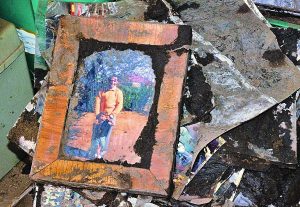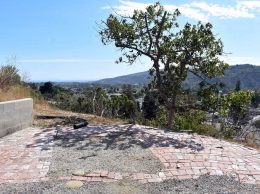The next phase: As lawsuits pile up, disaster victims look for accountability

A family photo lies in a pile of mud and debris after mudslides ravaged Montecito. (Robert Shutt photo)
Lawsuits continued to mount against Southern California Edison, contending that the utility was at fault in the Thomas fire and subsequent mudslides, while business leaders began to rally efforts to strengthen sales.
Two filings in the Santa Barbara County Superior Court joined added to lawsuits in Ventura County, naming SCE as well as the city of Ventura and the Montecito Water District as defendants and seeking damages for properties lost in the dual disasters.
Two of the cases in Ventura County are class action suits, and all total, more than 45 parties have joined as plaintiffs. The “mass tort” cases will likely be bundled for pre-trial purposes, said Westlake Village attorney Alexander Robertson, the lead attorney in seven of the nine cases.
In a statement to the Business Times, SCE declined to comment on the suits and said that “In regard to the potential causes of the Thomas Fire, the investigation by Cal Fire is ongoing. At this time, it would be premature for SCE to speculate on their investigation.”
Many of the parties are running up against insurance limits on things like debris removal or tree replacement, Robertson said.
“Most of our clients’ insurance carriers have been accepting coverage, but most people are underinsured,” he said. Because the material might have contaminants in it, “our clients are finding the cost estimates to remove the mud and debris from their homes in Montecito are in the six figures … There are a lot of damages that are simply not going to be covered by a simple homeowners’ insurance policy.”
The Casitas Municipal Water District was no longer named as a defendant in Ventura County. Robertson said that, barring a settlement, the cases could take 12 to 18 months to go to trial.
TOURISM TAKES HITS
Business organizations also circled the wagons, looking for ways to support retailers, restaurateurs and hoteliers who had lost sales during the crises.
Tourism marketing agency Visit California estimated that Santa Barbara County lost $949,000 in visitor spending per day that Highway 101 was closed, amounting to more than $11 million during the nearly two weeks of shutdown.
The high-profile nature of the disasters, receiving international media coverage and input from celebrities like Oprah, Ellen Degeneres and Rob Lowe, could have long-term impacts for tourism.
Efforts to help businesses rebound are also incorporating learnings from Northern California and other regions impacted by disasters, officials said.
In the short term, Visit Santa Barbara and the downtown association campaigned with social media, radio and signage like window clings to drive attendance and visitor spending for the Santa Barbara International Film Festival, concentrating on local drive markets.
In response to the losses in sales in December and January, the city of Santa Barbara set up a deferral program for transient occupancy tax and refunded licensing payments for outdoor dining to take some of the pressure off visitor-facing businesses, City Administrator Paul Casey said in an email to the Business Times.
Women’s Economic Ventures said that it was seeking funding to increase its capacity for disaster recovery aid while still meeting its existing commitments and contracts. It is offering “Quick Response Loans” of up to $10,000 to offset losses in sales or inventory, as well as distributing disaster recovery brochures and online information in both English and Spanish.
The organization also planned six workshops in February to bring together experts from the Small Business Administration, WEV and the Economic Development Collaborative – Ventura County to offer free consulting, business courses and help with loan applications.
LOOKING FOR ANSWERS
The UC Santa Barbara Economic Forecast Project engaged Visit Santa Barbara, Women’s Economic Ventures and the Chamber of the Santa Barbara Region to develop a questionnaire aimed at assessing lost wages, inventory and sales.
The university also released findings detailing the contents of the ash that blanketed the region in December.
Samples collected at 18 points throughout Santa Barbara, Goleta and Santa Paula showed elements like carbon, silicon, nitrogen, sulfur and hydrogen, as well as around 20 percent metal content. Because the ash was removed within a few weeks, exposure levels were not found to pose much risk, and only potassium from burned vegetation was found to exceed benchmark risk levels significantly.
“Although the individual levels of these metals and other elements is below the screening levels, their combined presence in the ash is of concern,” environmental biogeochemist Arturo Keller said in a news release Feb. 1. “It was very wise to have received early on the recommendation from authorities to avoid being outdoors during the fires and to use the masks to reduce the likelihood of inhalation.”
The team hopes to find funding to continue the research and is currently studying impacts for water quality in watersheds and along the coast.
“We hope to provide this very useful information to our community and the authorities to better assess any residual risks,” Keller said.











